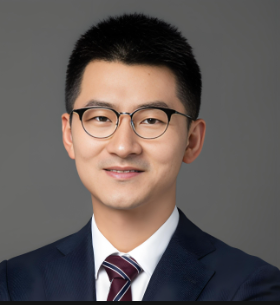Dr. Xinghua Cheng(meet up with Top Lung Cancer expert in Shanghai)

Dr. Xinghua Cheng
Administrative Deputy Director of the Department of Thoracic Surgery at Shanghai Chest Hospital, Deputy Chief Physician (Thoracic Surgery), Master’s Thesis Supervisor and Associate Researcher at Shanghai Jiao Tong University School of Medicine;
Shanghai Outstanding Young Talent, recipient of the Shanghai Talent Development Fund, Shanghai Municipal Health and Family Planning Commission Excellent Young Medical Talent, Shanghai Jiao Tong University Jiulong Outstanding Young Medical Talent, and Shanghai Chest Hospital Excellent Young Talent;
Member of the International Association for the Study of Lung Cancer (IASLC), Member of the European Society of Thoracic Surgeons (ESTS), Member of the Chinese Medical Education Association Lung Tumor Professional Committee, Youth Member of the Chinese Anti-Cancer Association Science Popularization Professional Committee, Youth Member of the Shanghai Medical Association Oncology Branch, and Member of the Shanghai Medical Association Digital Medicine Branch;
Published over ten SCI papers and led several national, ministerial, and bureau-level research projects.
Specializes in the surgical diagnosis and treatment of thoracic tumors, including the management of ground-glass nodules, minimally invasive surgical treatment for early-stage lung cancer, comprehensive treatment for mid-to-late stage lung cancer, and the diagnosis and treatment of common thoracic surgical conditions such as pneumothorax, pulmonary bullae, pectus excavatum, and mediastinal tumors.
Yewen Renyi: In 2020, statistics showed that the five-year survival rate for men after lung cancer surgery was 69%, and for women, 82.9%, surpassing global leading standards. What do you think are the "secrets" behind China’s early-stage lung cancer survival rates rivaling those of Europe and the U.S.?
Xinghua Cheng: There are two main factors. First, the popularization of screening. Early detection, diagnosis, and treatment form a systemic approach. Treating cancer at an early stage undeniably improves survival rates and reduces treatment costs.
Second, technological advancements. For decades, our surgical techniques trailed behind Western nations, but over the past 10–20 years, thoracic surgery in China has achieved remarkable progress. In terms of surgical skill, we are now at the forefront globally. However, we must remain humble. Disparities in standardized care persist across regions and hospitals in China. Additionally, we need to further advance R&D in both surgical techniques and pharmaceuticals. As surgeons, we must stay true to our初心 (original aspiration) and keep striving.
Yewen Renyi: With increasingly sensitive detection technologies, the incidence of pulmonary nodules—especially ground-glass nodules—is rising. What exactly are these nodules, and how are they linked to lung cancer?
Xinghua Cheng: Studies show that 20%–30% of asymptomatic individuals have nodules detected via CT scans. Let me use an analogy: Nodules are like "moles" in the lungs. Most are benign and harmless, just as most moles on the skin aren’t dangerous.
Ground-glass nodules (GGNs) do not equal lung cancer. Many benign conditions—like inflammation, minor bleeding, or fungal infections—can mimic GGNs. However, about 70%–80% of persistent GGNs not caused by inflammation may represent pre-cancerous lesions, in situ cancers, or very early-stage lung cancers. Not all require surgery. Think of in situ cancers as "parked cars": some remain dormant indefinitely; others "start their engines" but haven’t moved—the optimal time for intervention. Surgeons must balance seizing the right moment and avoiding overtreatment.
Yewen Renyi: Do you recall your first robotic surgery with Professor Luo Qingquan in 2015?
Xinghua Cheng: Absolutely. Working with Professor Luo, we performed China’s first robotic thoracic surgery at Shanghai Chest Hospital. It was groundbreaking—a leap beyond manual operation. Robotic surgery is undoubtedly the future, and we’re proud to pioneer its clinical application while exploring its full potential.
Yewen Renyi: Beyond clinical work, you’ve excelled in research and medical innovation, winning third prize in two categories at the 3rd China Medical Device Innovation and Entrepreneurship Competition. Could you share more?
Xinghua Cheng: This innovation addressed a clinical pain point. While surgery itself is painless under general anesthesia, preoperative CT-guided nodule localization—critical for precision—is done under local anesthesia, causing significant patient anxiety and discomfort. My team and I conceptualized an augmented reality (AR)-based localization method to eliminate CT dependency, allowing the procedure to be completed under general anesthesia. As a surgeon with an "engineer’s heart," I collaborated with technical experts to develop this system. We aim to bring it to clinics soon, minimizing patient suffering and advancing truly minimally invasive, precision treatment.
Yewen Renyi: If you could recommend one book to young students, what would it be?
Xinghua Cheng: At a Shanghai Library event, I recommended The Emperor of All Maladies: A Biography of Cancer by Siddhartha Mukherjee. It chronicles humanity’s battle against cancer—revealing both the evolution of treatments and the timeless struggles and courage of doctors. Cancer, born from mutated normal cells, is humanity’s "ultimate internal enemy." The war is fought not with weapons but through relentless innovation. Every breakthrough begins with stubborn persistence. As doctors, we remain forever on this path, hoping to return with the same youthful passion we began with.

